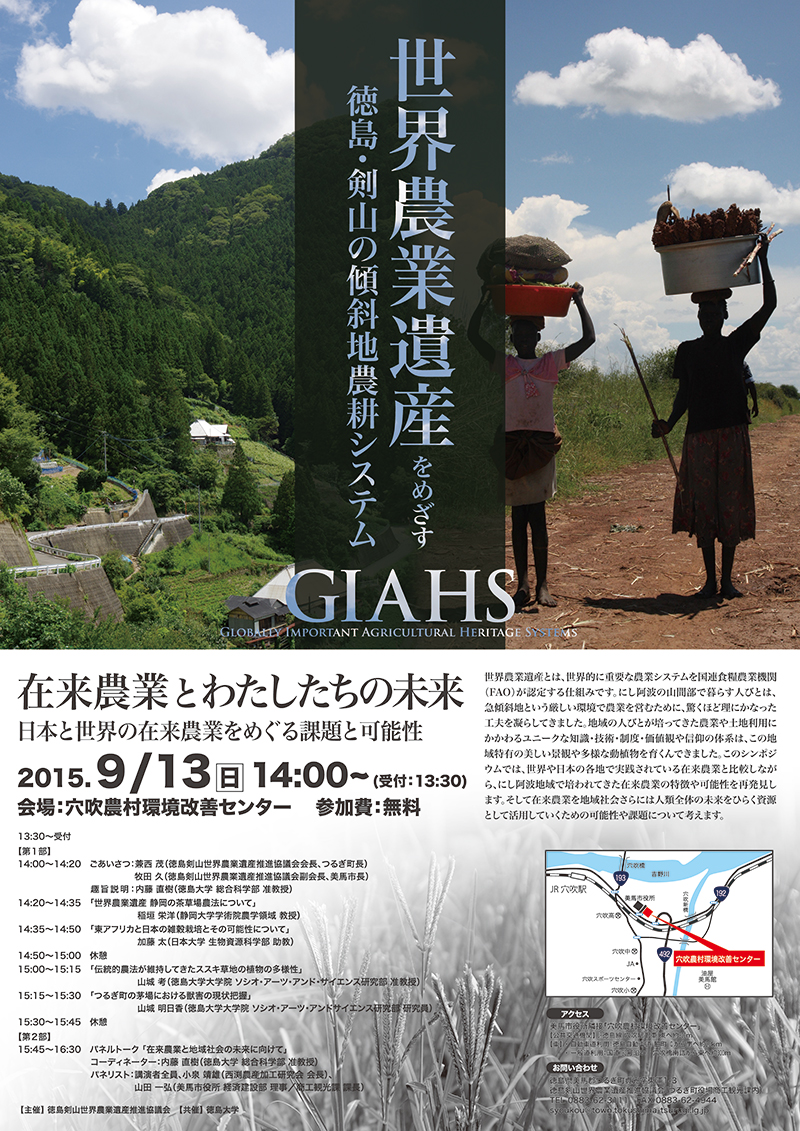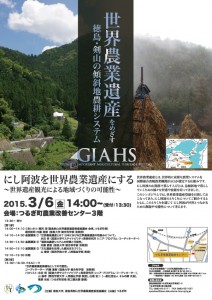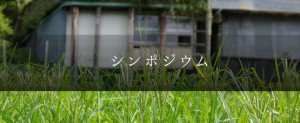| Title: | Indigenous Agriculture and Our Future: Challenges and Possibilities for Indigenous Agriculture in Japan and Worldwide |
| Date: | September 13, 2015 |
| Venue: | Anabuki Rural Environment Improvement Center |
The people living in the mountainous region of Nishi-Awa, called "Sora" in ancient times, have developed surprisingly ingenious ways to farm in the harsh environment of the steep slopes, which sometimes have slopes of 30 degrees or more. The unique knowledge, techniques, systems, values, and beliefs of the local people, related to agriculture and land use, have nurtured beautiful landscapes and a wide variety of flora and fauna unique to this region. However, these indigenous farming and land-use practices as well as the cultures, landscapes, and associated species are in jeopardy amid the modernization of society and agriculture. Indigenous agriculture may indeed be unattractive according to the values of the "modern agricultural model," which places the highest value on mass production, mechanization, and efficiency. However, from the perspective of energy sustainability, stable food supply, and values and feelings toward the land, the importance of indigenous agriculture may increase in the future. In addition, in recent years, tourism development and cultural movements based on indigenous agriculture and culture have been flourishing in many parts of the world. In this symposium, we rediscover the characteristics and potential of indigenous agriculture practiced in the Nishi-Awa region by comparing it with the indigenous agriculture practiced in other parts of Japan and worldwide. This symposium also considers the possibilities and challenges of utilizing conventional agriculture as a resource for the future of local communities and the entire humanity.
Program
< Part 1 >
14:00~14:20
Opening remarks: Kanenishi Shigeru (Mayor of Tsurugi Town) and Hisashi Makita (Mayor of Mima City)
Introduction to the symposium: Prof. Naoki Naito (Tokushima University Graduate School of Technology, Industrial and Social Science)
14:20~14:35 Keynote speech 1:
“GIAHS Chagusaba in Shizuoka” by Pro. Hidehiro INAGAKI (Professor, Faculty of Agriculture, Shizuoka University)
14:35~14:50 Keynote speech 2:
“Millets Cultivation in East Africa and Japan and their Potential” by Pro. Futoshi KATO (Assistant Professor, College of Bioresource Sciences, Department of Agriculture, Nihon University)
14:50~15:00 Coffee break
15:00~15:15 Keynote speech 3:
“Plant diversity in Miscanthus-type grassland maintained by traditional farming methods” by Pro. Tadashi Yamashiro (Associate Professor, Graduate School of Socioarts and Science, Tokushima University)
15:15~15:30 Keynote speech 4:
“Assessing the current status of wild animal damage in Kayaba, where mowing Miscanthus-type grassland, Tsurugi town” by Dr. Asuka Yamashiro (Researcher, Graduate School of Socio-arts and Science, Tokushima University)
15:30~15:45 Coffee break
< Part 2 >
15:45~16:30
Panel discussion: “Toward the Future of Indigenous Agriculture and Local Communities”
Facilitator: Prof. Naoki Naito (Tokushima University Graduate School of Technology, Industrial and Social Science)
Panelists: Keynote speakers, Yasuo Koizumi (Nishibuchi agricultural production association), and Kazuhiro Yamada (Officer in Mima city hall)




